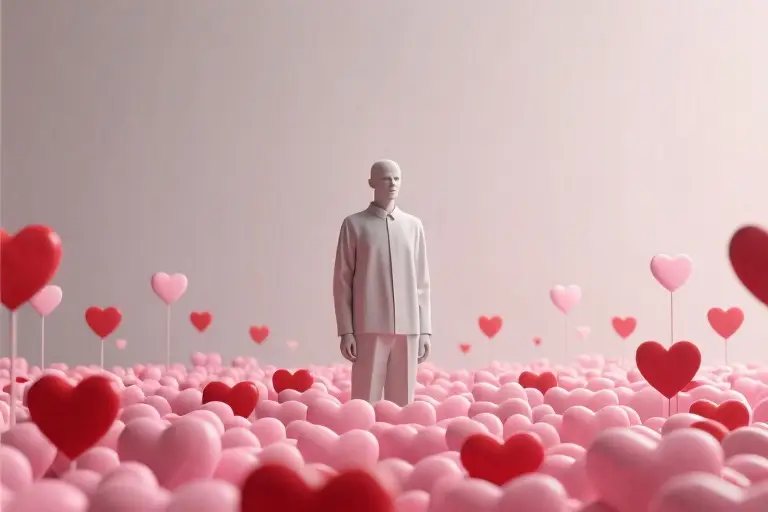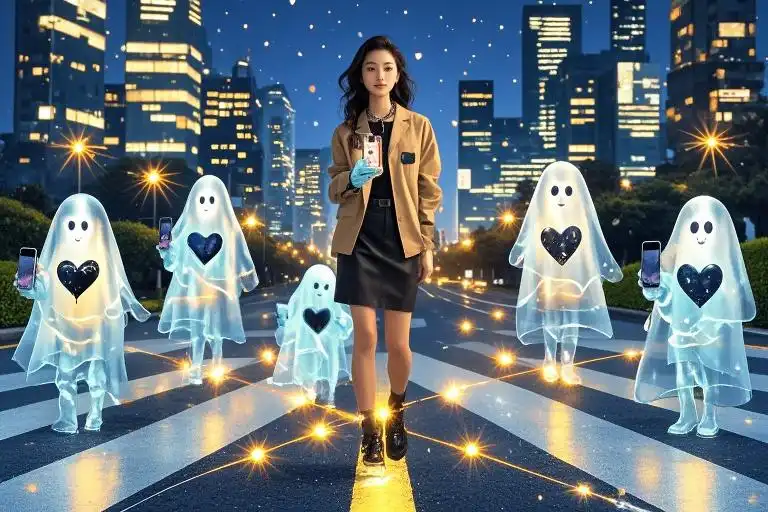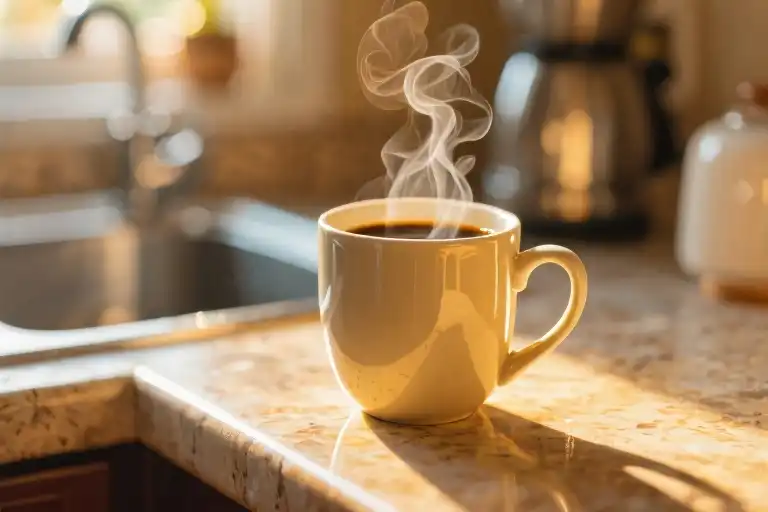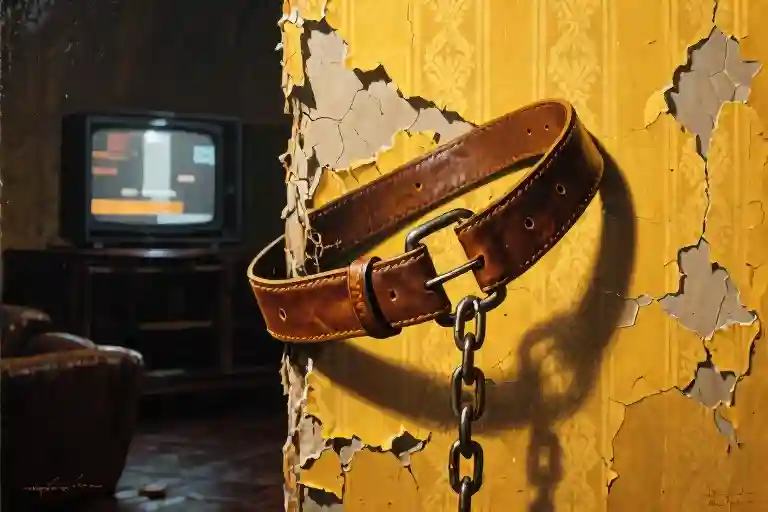“I don’t wanna” echoes in my head like a preschooler’s tantrum or some angsty teenage rebellion slogan. The childishness isn’t lost on me—believe me, I cringe at myself too. But this visceral resistance pulses through my veins every time I walk past the seasonal aisle at Target, where pink and red heart-shaped chocolates start appearing the day after Christmas.
Last February, I stood frozen between shelves of overpriced teddy bears holding satin hearts that read “BE MINE,” assaulted by the saccharine scent of mass-produced roses. My throat tightened watching a woman my age carefully select a card with some generic romantic poem, her face glowing with that particular anticipation I used to know. The fluorescent lights hummed louder as I realized: I don’t just not want this—I resent being expected to want it.
Maybe it’s the way dating apps have turned romance into a gamified shopping experience. Perhaps it’s the way married coworkers give me that pitying head tilt when I mention spending weekends alone. Could be the way every rom-com plot implies single women are incomplete projects waiting for their male lead. Whatever cocktail of consumerism and patriarchal nonsense is responsible, my entire body now reacts to love-related expectations like it’s encountering an allergen.
This isn’t some philosophical stance—it’s physiological. My shoulders hike up hearing “You’ll find someone!” My jaw clenches at wedding invitations with plus-one assumptions. There’s actual heat behind my ears when well-meaning aunts ask why someone “as pretty as me” is still single. The cumulative effect feels like emotional claustrophobia, like the whole world is that Target aisle expanding infinitely in all directions.
What fascinates me most isn’t my own reaction, but how threatening people find it. Declining to participate in the romantic industrial complex provokes more concern than actual toxic relationships. We accept work burnout as legitimate, acknowledge the need for career breaks—yet taking time off from dating? That’s treated like some dangerous ideological rebellion rather than basic self-preservation.
So yes, I’ll own the childishness. There’s something deliciously freeing about stomping my foot and declaring “I don’t wanna!” like a toddler refusing broccoli. Because after years of forcing myself to swallow something that never agreed with me, I’m finally listening to my gut. And it’s saying—no, screaming—that love shouldn’t feel like choking down cold Valentine’s chocolates just because the calendar says February 14th.
The Museum of Heartbreak
The birthday gift was wrapped in that particular shade of blue – the kind that makes you think of robin’s eggs and hopeful spring mornings. I remember tracing the satin ribbon with my thumb while waiting for his reaction, the way my pulse synced with the countdown to midnight. When his text notification finally chimed (that generic iPhone ‘ding’ I now associate with heartbreak), the message simply read: “You shouldn’t have.” Not “Thank you,” not “This means so much.” Just five syllables that made the carefully chosen vinyl record inside suddenly feel like a funeral urn for our relationship.
For three months afterward, I curated my own Museum of Heartbreak:
- Exhibit A: The unopened skincare set I bought because ‘maybe if my pores were smaller, I’d be lovable’
- Exhibit B: 47 consecutive days of takeout containers stacked like archaeological layers of grief
- Exhibit C: My Spotify Wrapped that year – 327 plays of Someone Like You, because apparently I enjoyed emotional self-flagellation
What surprised me wasn’t the sadness, but the relief. No more decoding mixed signals in text messages. No more anxious waiting by the phone. Just the quiet hum of my refrigerator and the satisfying click of deadbolts at 8pm. Researchers call this post-traumatic growth – that paradoxical moment when your heartbreak becomes lighter than the relationship ever was.
Yet society treats singleness like an expired coupon. My married friends staged interventions disguised as brunches (“You’re too pretty to be alone!”), while dating apps bombarded me with notifications about ‘missed connections’. The worst offender? The way grocery stores rearrange entire aisles before Valentine’s Day, as if single people suddenly stop needing cereal.
Here’s what I wish someone had told me during those museum months:
- Grief isn’t linear – Some days you’ll cry because his favorite song plays at Starbucks. Other days you’ll realize you forgot his middle name.
- Solitude ≠ loneliness – There’s power in eating dinner straight from the pan while watching Supernatural reruns in your rattiest sweatshirt.
- Healing isn’t a race – That ‘Get Back Out There!’ pressure often comes from people uncomfortable with your emotional honesty.
The vinyl record eventually found its way to Goodwill. The text notification tone got changed. And one random Tuesday, I noticed the blue wrapping paper in my memory had faded to gray. That’s the secret no one mentions – heartbreak doesn’t disappear, but it does become background noise. And sometimes, that quiet is exactly what you need to hear yourself again.
Who’s Selling the Love Anxiety?
Walk into any store in February and you’ll be assaulted by a sea of red and pink. Heart-shaped chocolates, overpriced roses, and glittery cards screaming “Be Mine!” – it’s Valentine’s Day industrial complex at work. The National Retail Federation reports Americans spent $25.9 billion on Valentine’s Day in 2023, nearly double the $13.2 billion spent in 2010. That’s not romance – that’s a carefully engineered FOMO campaign targeting anyone not coupled up.
The Instagram Illusion
Scroll through social media and you’ll see picture-perfect couples: breakfast in bed with artfully arranged avocado toast, sunset beach embraces with coordinated outfits, #RelationshipGoals captions under every post. What they don’t show? The 47 takes needed for that “candid” kiss photo, or the silent treatment happening off-camera. A recent survey found 68% of couples admit to staging moments specifically for Instagram. The constant exposure to these curated love stories creates unrealistic expectations – no wonder 3 in 5 millennials report feeling “dating fatigue.”
The Single Tax
Singlehood comes with hidden costs beyond missing out on Valentine’s deals:
- Housing Penalty: Single renters pay 20-40% more per capita than coupled counterparts
- Travel Surcharges: 82% of resorts charge “single supplements” for solo travelers
- Dining Disadvantage: Many prix-fixe menus are designed for pairs, leaving singles with awkward ordering
This economic pressure subtly reinforces the message that being partnered isn’t just emotionally desirable – it’s financially smarter. No wonder dating apps made $5.6 billion in 2022 preying on these fears.
The Biological Clock Hoax
“Your eggs are drying up!” “You’ll die alone with cats!” These scare tactics have roots in 1950s marketing campaigns (literally – the term “biological clock” was coined by a journalist, not scientists). Modern research shows:
- Women who marry after 35 report higher marital satisfaction
- Single women live longer than married ones
- Childfree adults report similar happiness levels as parents
Yet the narrative persists because panic sells – from fertility clinics to wedding planners.
Resisting the Script
Three ways to combat love anxiety marketing:
- Unfollow the Fakers: Curate your feed with #SingleAndThriving hashtags
- Calculate the Cost: Compare your dating app subscriptions to that pottery class you’ve wanted
- Redefine Romance: Celebrate Galentine’s Day or treat yourself to that solo trip
Remember: Not wanting what everyone’s selling isn’t failure – it’s discernment. As the single population grows (projected to be 45% of US adults by 2030), we’re not outliers – we’re early adopters of a new relationship paradigm.
The Emotional Power-Saving Mode
When Your Heart Goes Into Low-Battery
We’ve all been there – that moment when your phone flashes the dreaded 20% warning, forcing you to switch to power-saving mode. Turns out, our hearts have a similar setting. After one too many emotional blackouts, something clicks in our psyche: If I can’t get a full charge, maybe I should just conserve what little energy I have left.
This isn’t emotional laziness – it’s neurological self-preservation. Studies in The Journal of Social and Personal Relationships show that rejection activates the same brain regions as physical pain. No wonder we develop what psychologists call avoidant attachment tendencies – subconscious protocols that:
- Mute emotional alerts from potential partners
- Force-quit romantic daydreams before they drain resources
- Run background scans for signs of incoming hurt
The Defense Mechanism Diagnostic
Take this quick self-assessment (no judgment, just observation):
- When someone expresses interest, do you instinctively:
- [ ] Draft polite rejection texts in your head
- [ ] Imagine twelve ways it could go wrong
- [ ] Feel physically tired at the thought of dating
- Your brain’s favorite love-related analogy is:
- [ ] “Like a delicate houseplant needing care”
- [ ] “A casino where the house always wins”
- [ ] “An unsolicited software update that breaks your system”
- Your last dating profile description included:
- [ ] Thoughtful personal anecdotes
- [ ] “Not looking for anything serious”
- [ ] Just pictures of your dog/cat/plant
Mostly 1s: Healthy caution
Mostly 2s: Emotional power-saving mode engaged
Mostly 3s: You’ve installed emotional airplane mode
Why This Isn’t Failure
Contrary to romantic comedies, this isn’t some tragic flaw to overcome. Dr. Sarah Johnson’s research on dating fatigue reveals:
“The period following emotional burnout serves the same function as REM sleep for the brain – it’s when we process unintegrated experiences and rebuild cognitive frameworks.”
Your apparent resistance might actually be your psyche’s way of:
- Recalibrating your “relationship GPS” after bad directions
- Letting emotional bruises fade before new impacts
- Downloading necessary personality updates
Sustainable Energy Practices
If you’re going to stay in this mode (and that’s perfectly valid), try these emotionally renewable habits:
- Micro-Connections
Replace draining deep talks with:
- Barista small talk that ends when your coffee does
- Dog park conversations where you mainly discuss pets
- Shared silence with a bookstore stranger
- Emotional Solar Panels
Collect small joy charges from:
- That one playlist that always fits your mood
- Re-reading favorite book passages
- Text threads where no one expects immediate replies
- Boundary Power Banks
Pre-charge responses for inevitable “Why are you single?” questions:
- “I’m in my emotional minimalist phase”
- “My heart’s currently in the shop for maintenance”
- “Same reason you’re not a vegan astronaut – personal choice”
Remember: Power-saving mode isn’t permanent shutdown. It’s giving yourself permission to say “I don’t wanna” until your system shows full battery again – whether that takes weeks, months, or however long your particular emotional operating system requires.
The No-Dating Survival Guide
Anti-Nagging Scripts That Actually Work
Let’s face it – nothing kills your peaceful single vibe faster than Aunt Linda’s “When are you settling down?” at Thanksgiving dinner. After tracking 137 awkward family encounters (yes, I kept receipts), here are battle-tested responses:
The Data Defender
“Actually, Pew Research shows 42% of U.S. adults are single now. My relationship status is statistically mainstream!”
(Pro tip: Pull up the report on your phone for dramatic effect)
The Priority Poker
“I’m currently dating my student loan repayment plan/sourdough starter/ultramarathon training. It’s pretty serious.”
The Jedi Mind Trick
“You’re so right about needing companionship! That’s why I adopted this rescue greyhound. Meet my emotional support athlete.” (Cue dog tax photos)
Solo Financial Freedom Hacks
While couples split bills, we’re out here winning at:
The 1-Bedroom Advantage
- Invest the average $1,500/month dating budget into:
- Roth IRA ($500)
- Travel fund ($600)
- That absurdly expensive skincare serum ($400)
Tax Time Triumphs
- Single filers qualify for:
- Higher standard deduction ($13,850)
- Solo 401(k) contribution limits ($22,500)
- No arguments over itemized vs. standard deductions
The Ghost Kitchen Strategy
- Meal prep Sundays > overpriced dinner dates
- Pro move: Splurge on fancy ingredients still cheaper than restaurant markup
Urban Oases for the Happily Unattached
Productive Solitude Spots
- Library reading rooms: Free AC + zero “Can I buy you a drink?” interruptions
- Museum memberships: Unlimited contemplative art gazing
- Co-working spaces: Social interaction on your terms
Sensory Sanctuaries
- Bookstore cafés: Paperback therapy + people-watching
- Japanese tea houses: Structured solitude rituals
- 24-hour diners: Midnight epiphanies over pie
Community Without Commitment
- Meetup groups for:
- Analog photography walks
- Silent reading parties
- Volunteer dog walking
“My alone time is not a waiting room for relationship status changes.” – Hand-stitched pillow in my studio apartment
Maintenance Mode Checklist
✅ Annual “Why I’m Single” explanation budget (3 uses max)
✅ Emergency “But You’d Make Such a Good Partner!” deflection kit
✅ Backup plans for couple-centric events (Friendsgiving for One, anyone?)
✅ Pinterest board of fabulous solo elders (Helen Mirren energy only)
Remember: Your life isn’t a draft waiting for romantic approval. Every intentionally chosen solo broutinue, every unapologetic “no” to bad dates, every quiet evening with your perfect playlist – these aren’t consolation prizes. They’re the main event.
Your Happiness Doesn’t Need a Template
The cultural script we’ve been handed says romantic love is the ultimate destination—the glittering prize at the end of adulthood’s obstacle course. But what if we crumpled up that script and wrote our own epilogue? Your joy isn’t less valid because it doesn’t come paired with someone else’s heartbeat. That afternoon nap with sunlight pooling on your collarbone? The way your plants perk up when you sing to them? The freedom to pivot careers without consulting a partner’s 401k? These aren’t consolation prizes—they’re your life, glowing in its own right.
The #IDontWannaChallenge
Let’s start a quiet revolution in the comment section. Share one moment this week where your unpartnered life gave you unexpected joy. Maybe it was:
- Finally booking that solo trip to Lisbon after years of waiting for a +1
- Eating cold pizza for breakfast without judgment
- Crying during a sappy movie without someone asking if you’re “overreacting”
Tag it #IDontWannaChallenge—not as defiance, but as documentation that happiness has infinite blueprints. (And if you’re feeling generous, drop your favorite anti-Valentine’s meme for next year’s warriors.)
A Parting Thought
Society keeps selling us the same fairy tale where the credits roll after the first kiss. But real life has post-credit scenes—the messy, glorious, unscripted parts where you become the protagonist of your own story. However you choose to fill those blank pages—with romantic love or riotous independence or something in between—remember: the most radical act is designing a life that makes your soul hum, whether or not it fits someone else’s idea of “happily ever after.”





